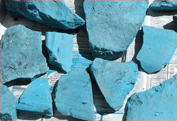Rodney Hill, Director of the Leisure and
Culture Trust, has revealed that The Wigan Pier complex (The Way We Were Heritage Centre)
is to end as we currently know it. The plan is for closure in 2007 as part of a £40m
project that will also sweep away other recreational facilities including Opie's Museum of
Memories, Wigan International Pool and the relocation of Wigan’s library (yet again).
The idea is for the Pier to be transformed into a cultural quarter complete with 500-seat
concert hall, apartments, bars, hotel and restaurants. As I understand it, the present
complex, although winning national awards and government charter marks year after year,
has just not been attracting enough people. What is disturbing however is the comments of
the Leisure Chief who has said that “The Way We Were depicts life in Wigan in 1900.
It is now 2004. That is why we are putting the focus on relevant industries and new
jobs.”. In Wigan as a whole there is precious little to remind us of our rich
heritage. By removing the Pier complex, Wigan may be in danger of becoming just another
bland over-developed, former industrial town with out-of-town retail parks identical to
the many others in the area. If you have any thoughts on the matter please let me know at
our next meeting.Dog Kennel mystery solved?
Mark Fletcher, our last month’s speaker, may have the answer to last month’s
mystery feature. He suggests that it is likely to be the site of a small gasholder used to
supply the Hall with lighting before being connected to the municipal supply. Gas for
lighting was invented at the turn of the 18th century by William Murdoch who developed a
method of extracting it from coal using an iron retort. By the mid 1900’s gas was
being used to light streets and factories up and down the country.
This seems a very plausible explanation - but is it correct? There are no records of gas
ever being used at the Hall before the Wigan Corporation connected a supply in the later
19th century - even then it was only used for cooking. In his book ‘Life and Times at
Haigh Hall’, Donald Anderson describes in some detail the use of candles, oil, naptha
(distilled from coal), paraffin and eventually electricity for lighting in the Hall
throughout the 19th century - but no gas. He also comments on the fact that, although many
country houses had their own small gasworks, Haigh Hall was without one, despite having a
ready supply of the best quality coal in Britain (Cannel) on site.
Ram Pump search
 Tom mentioned at
last months’ meeting that Sharon Saunders from the Parks and Gardens department has
asked us to search for their lost Ram Pump using our geophysics equipment. The Pump, which
was installed in the 19th century, was used to run the waterfall feature in Wigan’s
Mesnes Park. It stopped working many many years ago and its location has now been lost.
However the Parks department would now like to restore this feature hopefully using the
same pump. The Ram Pump is a unique device in that it can raise water using just the power
from the water flowing in a river or stream. It has no mechanical working parts therefore
requires very little maintenance; in fact the suppliers Green and Carter, who still make
them, give them a lifetime guarantee. It is difficult to imagine how you can make water
flow up hill in this way but this device uses the kinetic energy of the water to
pressurise a smaller continuous supply up to heights of 60 meters and more. Tom mentioned at
last months’ meeting that Sharon Saunders from the Parks and Gardens department has
asked us to search for their lost Ram Pump using our geophysics equipment. The Pump, which
was installed in the 19th century, was used to run the waterfall feature in Wigan’s
Mesnes Park. It stopped working many many years ago and its location has now been lost.
However the Parks department would now like to restore this feature hopefully using the
same pump. The Ram Pump is a unique device in that it can raise water using just the power
from the water flowing in a river or stream. It has no mechanical working parts therefore
requires very little maintenance; in fact the suppliers Green and Carter, who still make
them, give them a lifetime guarantee. It is difficult to imagine how you can make water
flow up hill in this way but this device uses the kinetic energy of the water to
pressurise a smaller continuous supply up to heights of 60 meters and more.
Tom and I have reconnoitred the site and with the help of our resistivity meter we believe
we should be able to locate its position.

Next Meeting
Wednesday 3rd November at the Baden Powel Centre (Scout HQ) in Greenough Street,
starting at 7.30 pm as usual. This month Dr Mike Nevell from Manchester
University will be reporting on the excavations carried out last year on the Gadbury
Fold site on the outskirts of Atherton. This unsuspected medieval site lies on
the line of the Roman Road from Manchester to Wigan, but what made the site extra special
was the discovery of a Pre-historic ditch complete with flint scraper (see Newsletter 66).
Hope to see you there. B.A.
|



